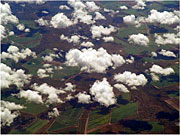- Number 337 |
- May 16, 2011
The problem of fair-weather clouds

Shallow, fair-weather cumulus
humilis clouds such as these
were sampled for the CHAPS
campaign in Oklahoma City,
Oklahoma.
Smaller cities can affect climate through pollution and fair-weather clouds, according to scientists at DOE’s Pacific Northwest National Laboratory and Brookhaven National Laboratory. The team gathered data from above Oklahoma City. Previous studies focused on larger cities, with populations in the millions, instead of smaller areas with populations in the hundreds of thousands. The researchers found that pollution increases the amount of light scattered by the fair-weather clouds, which look like cotton balls. The additional light scattering, which affects the climate, was caused by the amount of pollution in the air. The team concluded that human activities are changing clouds in many more locations than previously thought. The U.S. Department of Energy Atmospheric System Research Program supported this work from the Cumulus Humilis Aerosol Processing Study (CHAPS) Summer 2007 ASP Field Campaign.
[Kristin Manke, 509.372.6011,
kristin.manke@pnl.gov]
